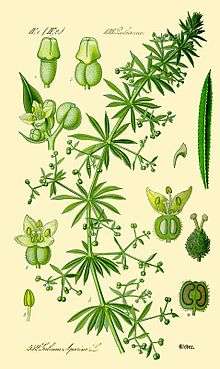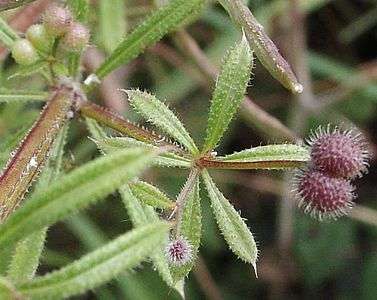Galium aparine
| Galium aparine Cleavers | |
|---|---|
 | |
| Scientific classification | |
| Kingdom: | Plantae |
| (unranked): | Angiosperms |
| (unranked): | Eudicots |
| (unranked): | Asterids |
| Order: | Gentianales |
| Family: | Rubiaceae |
| Genus: | Galium |
| Species: | G. aparine |
| Binomial name | |
| Galium aparine L. | |
| Synonyms[1] | |
| |
Galium aparine, with many common names including cleavers,[2] clivers, goosegrass,[2] catchweed,[2] stickyweed, robin-run-the-hedge, sticky willy,[2] sticky willow, stickyjack, stickeljack, and grip grass, is a herbaceous annual plant of the family Rubiaceae.
Description
Cleavers are annuals with creeping straggling stems which branch and grow along the ground and over other plants. They attach themselves with the small hooked hairs which grow out of the stems and leaves. The stems can reach up to three feet or longer, and are angular or square shaped.[3] The leaves are simple, narrowly oblanceolate to linear, and borne in whorls of six to eight.[3][4][5]
Cleavers have tiny, star-shaped, white to greenish flowers, which emerge from early spring to summer. The flowers are clustered in groups of two or three, and are borne out of the leaf axils.[6] The globular fruits are burrs which grow one to three seeds clustered together; they are covered with hooked hairs which cling to animal fur, aiding in seed dispersal.[6]
Distribution
The species is native to a wide region of Europe, North Africa and Asia from Britain and the Canary Islands to Japan. It is now naturalized throughout most of the United States, Canada, Mexico, Central America, South America, Australia, some oceanic islands and scattered locations in Africa. Whether it is native to North America is a question of some debate, but it is considered to be native there in most literature.[7] It is considered a noxious weed in many places.[8][9]
Effects on the body
For some people, skin contact with Galium aparine causes an unpleasant localized rash[10] known as contact dermatitis.
Chemistry
Chemical constituents of Galium aparine include: iridoid glycosides such as asperulosidic acid and 10-deacetylasperulosidic acid,[11] asperuloside, monotropein and aucubin, alkaloids such as caffeine, phenolics such as phenolic acids, anthraquinone derivatives such as the aldehyde nordamnacanthal (1,3-dihydroxy-anthraquinone-2-al),[12] flavonoids and coumarins, organic acids such as citric acid and a red dye.[13]
Edibility
Galium aparine is edible. The leaves and stems of the plant can be cooked as a leaf vegetable if gathered before the fruits appear. However, the numerous small hooks which cover the plant and give it its clinging nature can make it less palatable if eaten raw.[14][15] Geese thoroughly enjoy eating G. aparine, hence one of its other common names, "goosegrass".[16] Cleavers are in the same family as coffee. The fruits of cleavers have often been dried and roasted, and then used as a coffee substitute which contains less caffeine.[3][17]
Folk medicine
Poultices and washes made from cleavers were traditionally used to treat a variety of skin ailments, light wounds and burns.[18] As a pulp, it has been used to relieve poisonous bites and stings.[19] To make a poultice, the entire plant is used, and applied directly to the affected area.[20]
Other uses
Dioscorides reported that ancient Greek shepherds would use the barbed stems of cleavers to make a "rough sieve", which could be used to strain milk. Linnaeus later reported the same usage in Sweden, a tradition that is still practiced in modern times.[18][21]
In Europe, the dried, matted foliage of the plant was once used to stuff mattresses. Several of the bedstraws were used for this purpose because the clinging hairs cause the branches to stick together, which enables the mattress filling to maintain a uniform thickness.[15][22] The roots of cleavers can be used to make a permanent red dye.[23]
Ecology
The plant can be found growing in hedges and waste places, limestone scree and as a garden weed.[24][25]
The anthraquinone aldehyde nordamnacanthal (1,3-dihydroxy-anthraquinone-2-al) present in G. aparine has an antifeedant activity against Spodoptera litura, the Oriental leafworm moth, a species which is considered an agricultural pest.[12] The Acari Cecidophyes rouhollahi can be found on G. aparine.[26]
Photos
| Wikimedia Commons has media related to Galium aparine. |
|
References
- ↑ "The Plant List: A Working List of All Plant Species". Retrieved 20 June 2015.
- 1 2 3 4 USDA GRIN Taxonomy, retrieved 20 June 2015
- 1 2 3 Duke, James A. (2001). Handbook of Edible Weeds. CRC Press. p. 100. ISBN 9780849329463.
- ↑ Rabeler, Richard K. (2007). Gleason's Plants of Michigan. University of Michigan Press. p. 299. ISBN 9780472032464.
- ↑ Webb, D.A., Parnell, J. and Doogue, D. 1996. An Irish Flora. Dundalgan Press (W.Tempest) Ltd. Dundalk. 0-85221-131-7
- 1 2 Grieve, Maud (1971). "Clivers". A Modern Herbal: The Medicinal, Culinary, Cosmetic and Economic Properties, Cultivation and Folk-lore of Herbs, Grasses, Fungi, Shrubs, & Trees with All Their Modern Scientific Uses, Volume 1. Dover Publications. p. 206. ISBN 9780486227986.
- ↑ US Forest Service
- ↑ Kew World Checklist of Selected Plant Families
- ↑ Biota of North America Program
- ↑ Evanoff, K. (2013). "Bedstraw is a weed that bites back". Tribune Chronicle.[Link Evanoff]
- ↑ Iridoids from Galium aparine. D Deliorman, I Çalis, and F Ergun, Pharmaceutical Biology, 2001, Vol. 39, No. 3, Pages 234-235, doi:10.1076/phbi.39.3.234.5928
- 1 2 Antifeedant activity of an anthraquinone aldehyde in Galium aparine L. against Spodoptera litura F. Masanori Morimoto, Kumiko Tanimoto, Akiko Sakatani and Koichiro Komai, Phytochemistry, May 2002, Volume 60, Issue 2, Pages 163–166, doi:10.1016/S0031-9422(02)00095-X
- ↑ Rahman, Atta-ur (2005). Studies in Natural Products Chemistry: Bioactive Natural Products (Part L). Gulf Publishing Company. p. 291. ISBN 9780444521712.
- ↑ Edible Wild Plants: A North American Field Guide. Books.google.com. Retrieved 2013-08-14.
- 1 2 Tull, Delena. "Edible and Useful Plants of Texas and the Southwest." 1999, p. 145
- ↑ Dukes, James A. (2002). The Green Pharmacy Herbal Handbook. Macmillan. p. 102. ISBN 9780312981518.
- ↑ Wood, Matthew (2008). "Galium aparine. Cleavers. Lady's Bedstraw. Goosegrass.". The Earthwise Herbal: A Complete Guide to Old World Medicinal Plants. North Atlantic Books. p. 267. ISBN 9781556436925.
- 1 2 Grieve, Maud (1971). "Clivers". A Modern Herbal: The Medicinal, Culinary, Cosmetic and Economic Properties, Cultivation and Folk-lore of Herbs, Grasses, Fungi, Shrubs, & Trees with All Their Modern Scientific Uses, Volume 1. Dover Publications. p. 207. ISBN 9780486227986.
- ↑ Jones, Pamela. Just Weeds: History, Myths, and Uses. Prentice Hall Press, New York. 1991.
- ↑ Schneider, Anny & Mellichamp, Larry (2002). Wild Medicinal Plants: What to Look For, When to Harvest, How to Use. Stackpole Books. p. 73. ISBN 9780811729871.
- ↑ Loudon, John Claudius. "An encyclopædia of plants", 1836, p. 93
- ↑ Runkel, Sylvan T. & Roosa, Dean M. (2009). Wildflowers of the Tallgrass Prairie: The Upper Midwest. University of Iowa. p. 65. ISBN 9781587297960.
- ↑ Hutchens, Alma R. (1992). A Handbook of Native American Herbs. Shambala Publications. p. 97. ISBN 9780877736998.
- ↑ Hackney, P. (Ed)1992. Stewart & Corry's Flora of the North-east of Ireland. Third Edition. Institute of Irish Studies, The Queen's University of Belfast. ISBN 0 85389 446 9
- ↑ Clapham, A.R., Tutin, T.G. and Warburg, E.F. 1968. Excursion Flora of the British Isles. Second Edition. Cambridge University Press.
- ↑ A new species of Cecidophyes (Acari: Eriophyidae) from Galium aparine (Rubiaceae) with notes on its biology and potential as a biological control agent for Galium spurium. Charnie Craemer, Rouhollah Sobhian, Alec S. McClay and James W. Amrine Jr., International Journal of Acarology, 1999, Volume 25, Issue 4, pages 255-263, doi:10.1080/01647959908684162
Further reading
- Edible and Medicinal Plants of the West, Gregory L. Tilford, ISBN 0-87842-359-1
- Altervista Flora Italiana
%2C_Loch_Clunie_-_geograph.org.uk_-_1505032.jpg)


